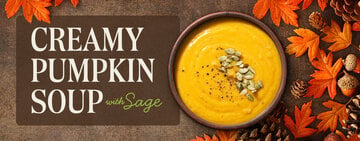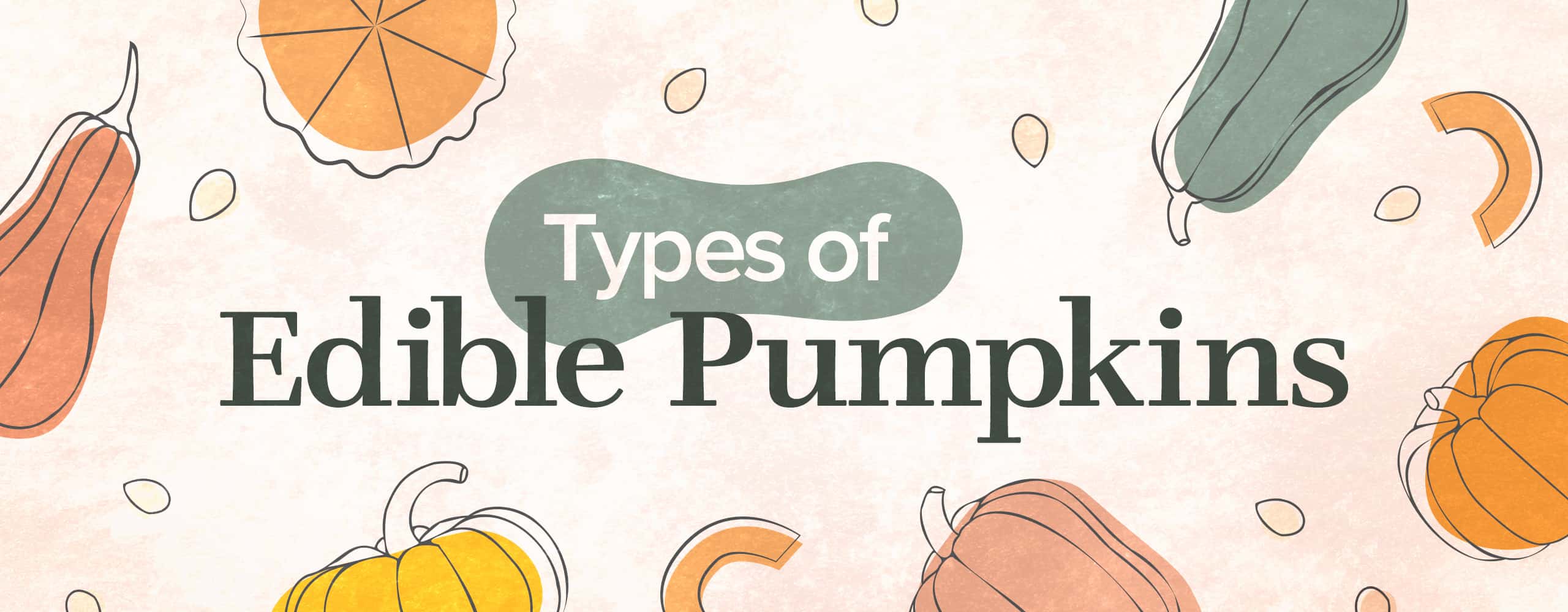
Pumpkins are not only a classic symbol of autumn, but they also offer a wide range of culinary possibilities. From comforting soups to delectable pies, these versatile winter squashes have been a favorite ingredient in many dishes for centuries. If you're a chef looking to create a new fall-inspired menu, understanding the different types of edible pumpkins is essential. From the trendy kabocha pumpkin to the timeless Cinderella pumpkin, each type brings a unique flavor profile and texture to the table. Dive into the world of edible pumpkins and create a special seasonal menu full of fall flavors.
What Is a Pumpkin?
A pumpkin is a type of winter squash that belongs to the Cucurbitaceae family. It typically has a round shape, a thick rind, and a fleshy interior. Pumpkins come in various sizes, ranging from small to massive. While we often associate pumpkins with bright orange colors, edible pumpkins come in hues ranging from white to orange to green to blue. Pumpkins are believed to have originated in Central America over 7,500 years ago and were an important crop for Native American tribes. The early settlers in America quickly recognized the value of pumpkins and began cultivating them for both their nutritional and medicinal properties. Today, pumpkins are grown worldwide, with the United States being the leading producer.
Types of Pumpkins with Pictures
Pumpkins are incredibly versatile in the culinary world. From sweet to savory dishes, there are countless ways to incorporate these flavorful fruits into your commercial kitchen. The flesh of a pumpkin is often pureed and used in soups, sauces, and pies, providing a rich and creamy texture. Additionally, pumpkin seeds, also known as pepitas, are a popular snack and can be used in baking or as a garnish for salads. We provide a list of edible pumpkins with photos so you can easily identify them and find the variety that is best for your cooking application.
1. Kabocha Squash
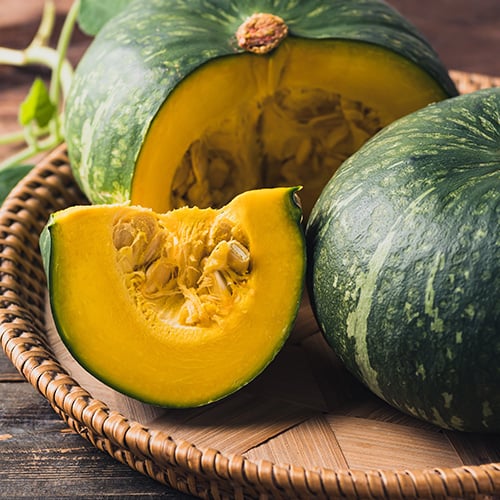
Kabocha squash is a unique variety of pumpkin that is gaining popularity in commercial kitchens for its distinct appearance, delicious flavor, and versatile uses. Its vibrant green skin, bumpy texture, and squat, round shape make it instantly recognizable. When you cut it open, kabocha squash’s deep orange flesh is dense and firm, perfect for holding its shape when cooked. Its rich, sweet flavor is often compared to a combination of butternut squash and sweet potato. This unique taste adds depth and complexity to any dish it's incorporated into.
- Kabocha Squash Flavor: Sweet, nutty, with a hint of malt
- Kabocha Squash Texture: Light and fluffy
- Kabocha Squash Uses: Soups, casseroles, curries, sauces, pies, muffins, quick bread
2. Honeynut Squash
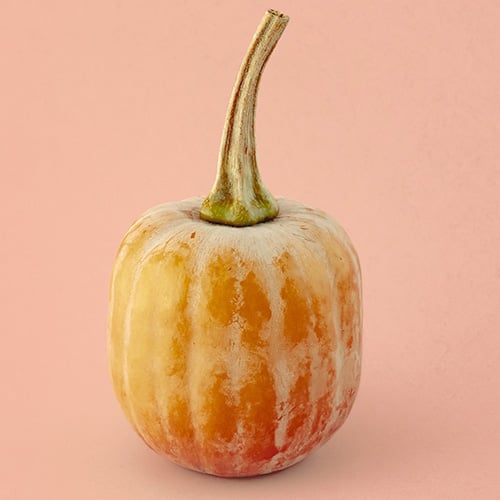
The honeynut squash is a small pumpkin, typically measuring around 4 to 6 inches in length. Despite its small size, the honeynut squash packs a big flavor punch. It offers a sweet and nutty taste laced with malty flavor notes. It has a distinct oblong shape. The skin is pale orange, and its flesh is vibrant and dense. Consider using honeynut squash puree to make a flavorful pumpkin milkshake.
- Honeynut Squash Flavor: Sweet, nutty, hint of malt
- Honeynut Squash Texture: Velvety, soft, and smooth
- Honeynut Squash Uses: Vegetable roasts, stuffed honeynut squash, creamy soups, desserts
3. Cinderella Pumpkin
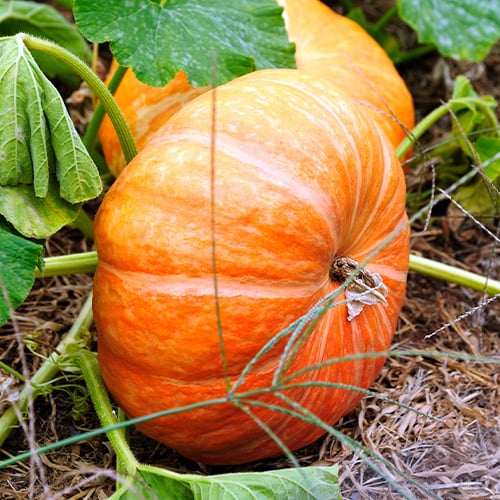
The Cinderella pumpkin is aptly named because its distinct shape resembles the iconic carriage from the beloved fairytale. With its deep orange hue and smooth, ribbed skin, this pumpkin catches the eye, but it’s also an incredible recipe ingredient. Known for its mild, sweet flavor, it can lend itself to either sweet or savory recipes. Its creamy and smooth flesh makes it ideal for purees, soups, pies, and pasta sauces.
- Cinderella Pumpkin Flavor: Mild, sweet pumpkin flavor
- Cinderella Pumpkin Texture: Moist
- Cinderella Pumpkin Uses: Pasta sauce, risotto, soup, pies, quick bread, muffins
4. Hubbard Squash
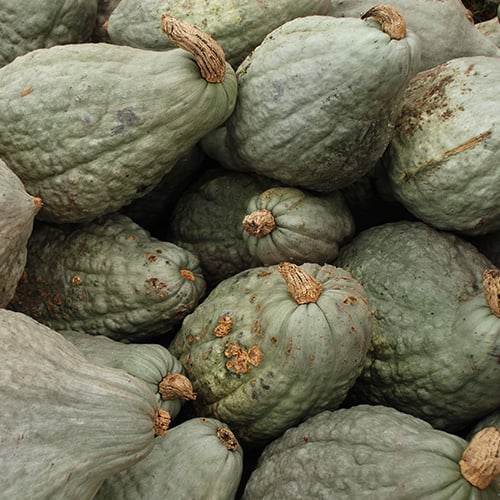
The Hubbard squash is a winter squash variety that originated in South America. Typically weighing between 10 and 20 pounds, this squash can grow to be quite large, making it perfect for feeding a crowd. Its skin is thick and rough, often displaying a vibrant orange or green color, and its bumpy texture adds to its rustic charm. When it comes to texture, the Hubbard squash has dense and firm flesh that holds its shape well during cooking, making it ideal for roasting, baking, or steaming. Its flavor profile can be described as sweet and nutty, with subtle earthy undertones. This unique combination makes it a versatile ingredient that pairs well with both sweet and savory dishes.
- Hubbard Squash Flavor: Sweet, hazelnut essences
- Hubbard Squash Texture: Dense and firm
- Hubbard Squash Uses: Roasted side dish, pies, muffins, tempura, curry, mashed
5. Calabaza Squash
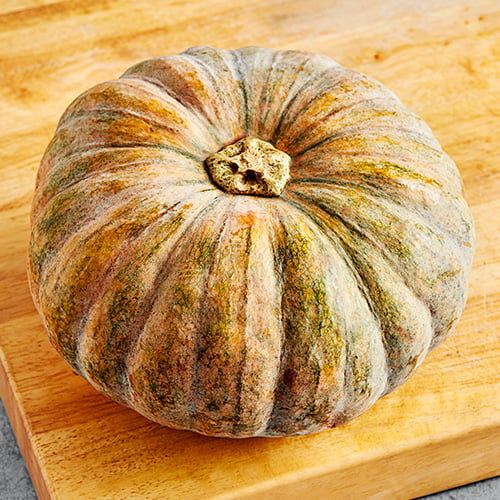
Calabaza squash, also known as West Indian pumpkin, is a popular variety of winter squash that originated in the Caribbean. This large, round pumpkin typically grows to about 10-20 pounds and has thick, pale orange skin. When it comes to taste, Calabaza squash has a mildly sweet and nutty flavor. The skin is thick and hard, providing excellent protection and a long shelf life. Inside, the flesh is a vibrant orange, dense, and firm, but it easily breaks down when cooked, resulting in a smooth consistency. This makes Calabaza squash a great choice for creating velvety soups or creamy pumpkin pies.
- Calabaza Squash Flavor: Nutty, mild sweetness
- Calabaza Squash Texture: Firm
- Calabaza Squash Uses: Tempura, stew, pies, enchilada filling, roasted side dish
6. Red Kuri Squash
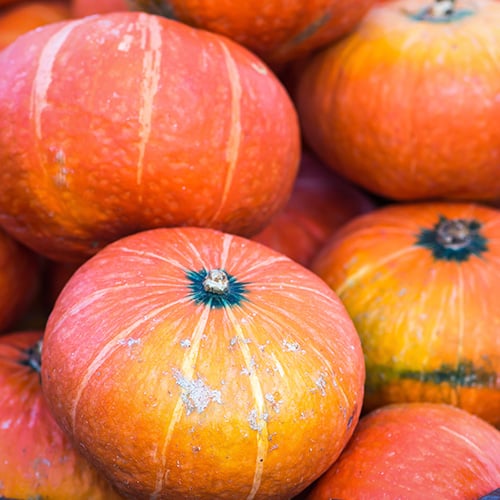
Also known as Japanese squash or Hokkaido squash, red kuri squash is a type of winter squash that originated in Japan but has gained popularity worldwide for its exceptional taste and beautiful appearance. It typically has a tear-drop shape and vibrant red-orange skin. Red kuri squash offers a smooth and sweet flavor profile that is often likened to chestnuts. When cooked, the flesh of this type of pumpkin becomes tender and velvety, making it a dream ingredient for purees, bisques, and creamy sauces. Its soft texture also lends itself well to being roasted or baked, resulting in a melt-in-your-mouth experience.
- Red Kuri Squash Flavor: Mild, sweet, earthy chestnut flavor
- Red Kuri Squash Texture: Tender, velvety
- Red Kuri Squash Uses: Bisques, pasta sauces, curries, risotto
7. Jarrahdale Pumpkin
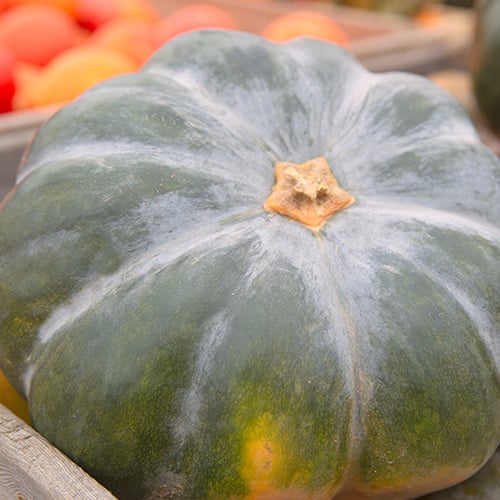
Named after the small town of Jarrahdale in Western Australia, the Jarrahdale pumpkin is a unique Australian heirloom variety of edible pumpkin. With its blue-grey skin and flattened shape, the Jarrahdale pumpkin is a true showstopper. One of the standout features of the Jarrahdale pumpkin is its smooth and creamy consistency. Pair its melt-in-your-mouth texture with its sweet, nutty flavor profile, and the Jarrahdale pumpkin is a dream ingredient for creating silky-smooth dishes.
- Jarrahdale Pumpkin Flavor: Sweet pumpkin flavor
- Jarrahdale Pumpkin Texture: Velvety
- Jarrahdale Pumpkin Uses: Bisques, pies, muffins, quick bread, cookies, cheesecake, scones
8. Buttercup Squash
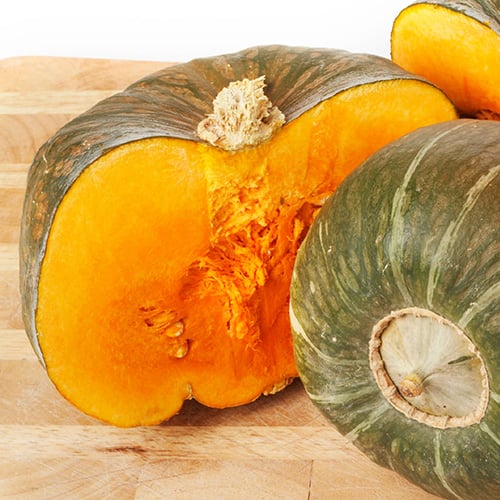
Buttercup squash is a winter squash known for its sweet flavor and creamy mouthfeel which intensifies when roasted. Its flesh is dense, mildly sweet, and has nutty undertones that add depth to both savory and sweet recipes. This makes it a great choice for soups, stews, casseroles, and even desserts. You can roast it, steam it, bake it, or puree it to use as a base for sauces and soups. Its natural sweetness pairs well with warm spices like cinnamon, nutmeg, and ginger, making it a perfect ingredient for comforting fall recipes. The squash is characterized by its dark green skin and distinctive turban shape, making it a visually appealing addition to any farmer's market stand.
- Buttercup Squash Flavor: Sweet and creamy
- Buttercup Squash Texture: Dense, firm, and non-fibrous
- Buttercup Squash Uses: Pies, muffins, soups, casseroles, curry, risotto, pasta sauce, salads
9. Carnival Squash
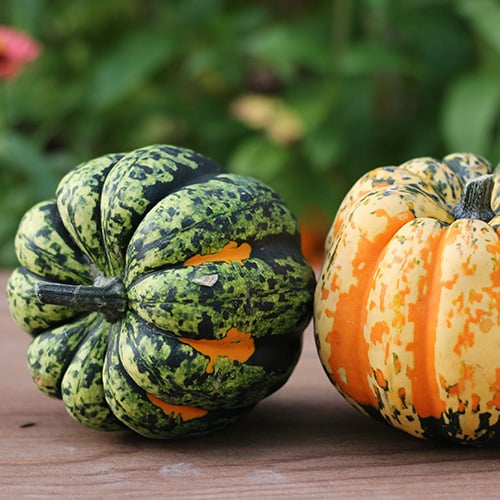
Carnival squash is a small- to medium-sized winter squash. Its name comes from its beautiful, carnival-like appearance, featuring a blend of colors that can include orange, yellow, green, and cream. This eye-catching exterior makes it a popular choice for decorative purposes during the fall season. However, carnival squash is not just aesthetically pleasing. It also offers a delicious flavor that is often described as sweet, nutty, and buttery. Its soft texture easily absorbs flavors from herbs and spices, resulting in flavorsome dishes.
- Carnival Squash Flavor: Maple, butter, and nut undertones
- Carnival Squash Texture: Creamy and buttery
- Carnival Squash Uses: Vegetable roasts, stuffed carnival squash, cheesecake, cupcakes, custard
10. Fairytale Pumpkin
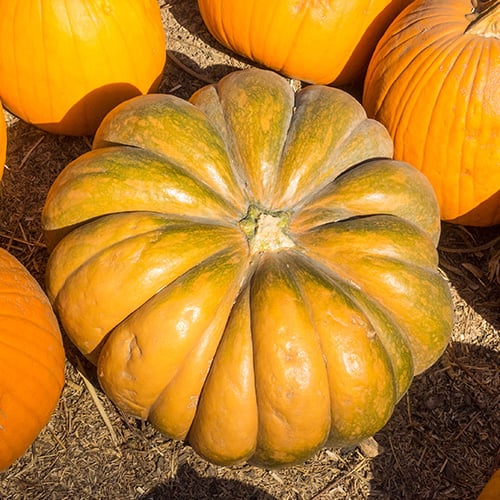
Fairytale pumpkins are a variety of winter squash that originated in France and are also known as Rouge Vif d’Etampes. They are vibrant orange, round, and deeply ribbed, just like the pumpkin carriage from the classic fairy tale. In terms of taste, fairytale pumpkins offer a sweet and nutty flavor. When roasted, their natural starches caramelize and turn to sugar, producing a scrumptious base for fall desserts. Additionally, their dense and creamy flesh is fine-grained, making them one of the best types of edible pumpkins for baking applications like our pumpkin creme brulee recipe.
- Fairytale Pumpkin Flavor: Rich, very sweet, buttery
- Fairytale Pumpkin Texture: Smooth and dense
- Fairytale Pumpkin Uses: Creme brulee, cupcakes, cheesecake, mousse, pie, frosting, ice cream
11. Sugar Pie Pumpkin
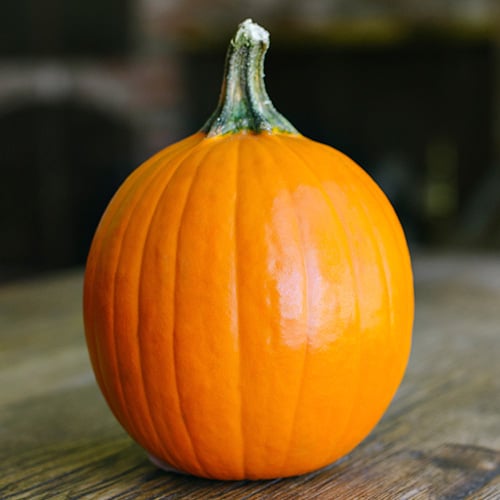
The sugar pie pumpkin, also known as sugar pumpkin, is a small pumpkin that is prized for its sweet and smooth flesh. This variety is specifically cultivated for its culinary uses, making it the go-to choice for homemade pumpkin pies, custards, and other delectable treats. What sets the sugar pie pumpkin apart from other varieties is its ideal balance of sweetness and texture. Its flesh is fine-grained and dense, offering a creamy smooth, consistency. It’s packed with natural sugars, giving it a rich and indulgent flavor. When cooked, the sugar pie pumpkin transforms into a velvety puree that adds depth and sweetness to any dish it graces. But the sugar pie pumpkin isn't just limited to desserts. Its mild and slightly nutty flavor makes it a great addition to soups, stews, and roasted vegetable medleys.
- Sugar Pie Pumpkin Flavor: Rich, buttery, sweet
- Sugar Pie Pumpkin Texture: Creamy, tender, smooth
- Sugar Pie Pumpkin Uses: Pies, quick bread, vegetable roasts, salads, casseroles, soups
12. Long Island Cheese Pumpkin
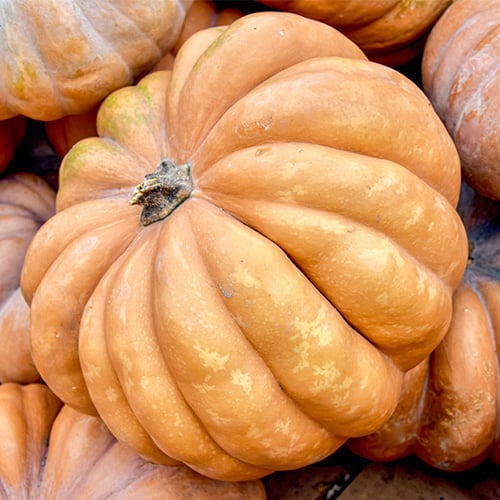
The Long Island cheese pumpkin is known for its distinct shape and pale orange color. It has a flattened appearance, similar to a wheel of cheese, hence its name. Its smooth skin and deep ridges give it an attractive and rustic look, but this pumpkin isn't just for show. It's also highly regarded for its culinary uses. The Long Island Cheese Pumpkin has a sweet and nutty flavor, making it perfect for baking, roasting, or pureeing. Its flesh is dense and creamy, making it ideal for pies, soups, and other pumpkin-based dishes.
- Long Island Cheese Pumpkin Flavor: Mild, pairs sweet with earthy
- Long Island Cheese Pumpkin Texture: Tender, creamy
- Long Island Cheese Pumpkin Uses: Curries, sauces, soups, stir-fries, tarts, quick bread, pies
Back to Top
The edible pumpkin possibilities are endless. Whether you're looking to make a delicious pumpkin pie, a pumpkin tempura appetizer, or a creamy bisque, there's a type of edible pumpkin that's perfect for your dish. Reference this guide as you update your fall menu to find the perfect edible pumpkin for every application.



